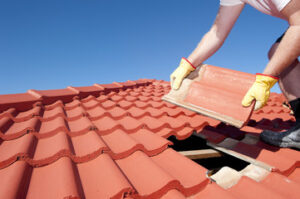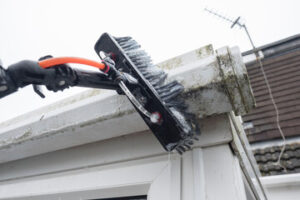Roofing is the process of covering the top of a building to protect against rain, snow, sunlight and wind. There are a variety of materials used in roofing, including asphalt shingles, slate, clay or metal.

Roofers Wilmington DE start each day with a safety talk and attend yearly training. They work with a team on flat or pitched roofs, often on ladders and in the sun.
The average roof replacement costs about $30,000, and it’s one of the biggest expenses a homeowner can face. However, homeowners can reduce the cost by choosing a cheaper shingle type or by opting for partial reroofing. Regardless, it’s important to hire a licensed roofing contractor for the job. This ensures that the contractor has the necessary skills to complete the work quickly and efficiently. In addition, it helps protect the homeowner from any legal issues that could arise if they attempt the job themselves.
Homeowners should understand the terms that their roofing contractor uses while discussing the price of the project. For example, most contractors refer to a “roofing square,” which is a unit of measurement unique to the industry that makes it easier for the contractor to calculate ordering and material costs. A roofing square is the equivalent of 10 by 10-foot sections of a roof or 100 square feet.
Another significant factor in the overall cost of a new roof is the type of materials used. Shakes, which are split into wedges to produce a natural, rugged look, are more expensive than shingles, which are sawmilled into uniform lengths and thicknesses for clean lines. Clay tiles are also more costly than shingles but have a longer lifespan, lasting 50 to 150 years.
Other factors that can add to the cost of a re-roofing project include the cost of materials, permits, waste removal, and other associated fees. Typically, the cost of replacing the roof decking is included in the total cost of the project, which can be more expensive than a full replacement.
Durability
Durability is a top consideration for homeowners when choosing a roof replacement. A durable roof is able to withstand rain, snow, sunlight, and wind, all while providing protection from the elements. The longevity of a roof depends on the material, climate, and installation. Asphalt shingles last 15 to 20 years, metal roofs up to 50, and slate can last for more than 100. Durability also depends on regular maintenance and repair, such as fixing leaks as soon as they occur. Leaks often happen at penetrations, such as plumbing vents or skylights. Adding weather stripping to these areas can help. Lastly, rooftop gardens (modern ones known as green roofs, traditional ones as sod or turf) offer insulating benefits and can help reduce urban heat islands. These roofs require a bit more maintenance, but can add beauty and value to your home.
Fireproofness
In areas at risk for wildfires, a fireproof roof is an important feature to consider. Embers from other homes or nearby vegetation can ignite your roof, damaging or even burning through it to reach the structure underneath.
Most roofing materials go through strenuous testing to determine their fire ratings, which are based on how they react during a fire and whether or not they produce flying embers. The best fire resistant roofing materials earn a Class A rating, which is the highest available and means they’re non-combustible and can survive severe fire exposure. Some examples include metal roofing, concrete tiles and composition shingles.
Many other roofing materials fall into the Class B and Class C categories, which aren’t as effective against fire or don’t withstand severe fire testing. These types of roofing materials can be treated with chemical retardants to make them more fire-resistant, but they aren’t as good as a Class A rated roofing material. Examples of these kinds of roofing materials are reconstituted wood products and untreated wood shakes or shingles.
The roof is the most vulnerable part of a home during a wildfire, and you want to be sure that the new or replacement roof is fire-resistant. Checking that your new roof is a class A roofing material is an important step, but you should also look at the entire structure of the building to ensure it’s fire-resistant as well.
For example, if your roof is made of clay tile, it’s a great choice for Southwestern, mission or Spanish-style architecture, but you need to be careful with upkeep. If the gaps between the underlayment and the soffit or roof sheathing aren’t properly sealed, embers can bypass the fire resistance of the tiles and damage the roof, insulation or electrical boxes.
Wind Resistance
The quality and durability of the roofing materials used to construct a roof have a major impact on its ability to resist damage from high winds. Homeowners in regions prone to strong storms and hurricane-force winds should prioritize wind uplift resistance when choosing a roofing material for their new roof or roof replacement.
When high-speed winds encounter a roof, they create updrafts that can lift shingles and force them away from the framing of a home. This can cause damage to the soffits and fascia, and may even tear off the roof itself. To reduce the risk of these damages, homeowners should regularly inspect their roofs for damaged shingles and make repairs as needed.
In addition, homeowners should consider the UL 1897 rating of their roofing material. This rating indicates how much wind uplift the roof can withstand, with higher numbers indicating greater resistance. Typically, the UL 1897 rating is listed in the roofing product specifications or on the manufacturer’s documentation. Homeowners can also consult with a professional roofing contractor for assistance.
Fortunately, there are several roofing materials that offer excellent wind uplift resistance. For instance, roofers often recommend asphalt shingle varieties that feature improved adhesive seals and reinforced designs to combat wind uplift. In addition, metal roofs can provide a strong barrier against uplift forces, due to their sturdy construction and lightweight design. Slate tiles are another popular choice for their strength and durability, which can help prevent uplift damage in storms.




